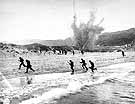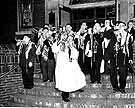
|
|
|

|

|

|

|
|
Click on an image to see a larger, more detailed picture.
|
|
|
|
|
| 1944: Desperate Acts |

|
pg. 532 |

|
|
|
|
| |
 American, British, Canadian, and other Allied troops landed at Normandy, France, on June 6, 1944. The invasion forced Germany into a two-front war (with the Soviets attacking from the east), a war Germany could not win. Although held up for weeks in the difficult Norman terrain, the Allies eventually broke through. They then swept quickly across France and approached Germany's borders by December. As the Allies gradually conquered territory, they encountered and liberated concentration camps.
American, British, Canadian, and other Allied troops landed at Normandy, France, on June 6, 1944. The invasion forced Germany into a two-front war (with the Soviets attacking from the east), a war Germany could not win. Although held up for weeks in the difficult Norman terrain, the Allies eventually broke through. They then swept quickly across France and approached Germany's borders by December. As the Allies gradually conquered territory, they encountered and liberated concentration camps.
Photo: Paul Grisso/United States Holocaust Memorial Museum Photo Archive
|
 On the eve of the June 6 D-Day invasion, Jewish men gather on the steps of the synagogue at the Brooklyn (New York) Hebrew Home and Hospital for the Aged. Wearing prayer shawls and blowing the shofar (ram's horn) to call people to gather for prayer, these elderly Jews pleaded for a speedy Allied victory that would end the Nazi reign and bring an end to the suffering of the Jews of Europe.
On the eve of the June 6 D-Day invasion, Jewish men gather on the steps of the synagogue at the Brooklyn (New York) Hebrew Home and Hospital for the Aged. Wearing prayer shawls and blowing the shofar (ram's horn) to call people to gather for prayer, these elderly Jews pleaded for a speedy Allied victory that would end the Nazi reign and bring an end to the suffering of the Jews of Europe.
Photo: Corbis-Bettmann
|
 Living in Filth
Living in Filth
The Germans attempted to destroy Jewish hearts, souls, minds, and bodies in many ways, often involving excrement. This was an aspect of German policy: Degrade the Jews by forcing them to live and die in an environment that was dominated by filth. Troops locked deportees in freight cars with no provisions for excretion. Camp barracks were running rivers of filth, filled with dirt, vomit, disease, and excrement. At the Bergen-Belsen, Germany, camp, one latrine served 30,000 women prisoners. Prisoners at almost all camps caught typhus and/or dysentery, both of which caused diarrhea. Many prisoners tied string around the bottom of their trousers to catch their excrement, thus saving themselves from being beaten or killed for taking time to try to get to a latrine. Reska Weiss wrote of prisoners who were "not even animals, but putrefying corpses moving on two legs."
Photo: Zbidr Fotografil
|
|

|

|

|

|
 June 10, 1944: In the French village of Oradour-sur-Glane, Germans kill 642 residents as revenge for the killing of an SS officer by a Resistance sniper. Women and children are burned alive in a church and the men are machine-gunned. Of the 642 victims, seven are Jewish refugees who had escaped deportation to Auschwitz by living with sympathetic Oradour-sur-Glane villagers. Included among the dead is eight-year-old Serge Bergman.
June 10, 1944: In the French village of Oradour-sur-Glane, Germans kill 642 residents as revenge for the killing of an SS officer by a Resistance sniper. Women and children are burned alive in a church and the men are machine-gunned. Of the 642 victims, seven are Jewish refugees who had escaped deportation to Auschwitz by living with sympathetic Oradour-sur-Glane villagers. Included among the dead is eight-year-old Serge Bergman.
|
 June 11-16, 1944: Germans ship an additional 50,805 Hungarian Jews to Auschwitz.
June 11-16, 1944: Germans ship an additional 50,805 Hungarian Jews to Auschwitz.
|
 June 14, 1944: Two thousand Jews are deported from Corfu, Greece, to Auschwitz.
June 14, 1944: Two thousand Jews are deported from Corfu, Greece, to Auschwitz.
|
|
|
|
|
| 1944: Desperate Acts |

|
pg. 532 |

|
|
The Holocaust Chronicle
© 2009 Publications International, Ltd.
|
|
